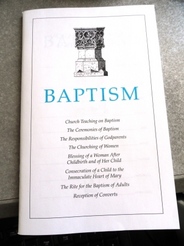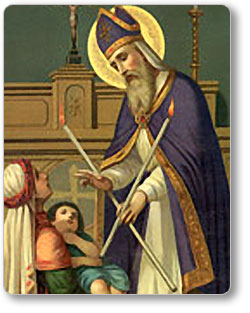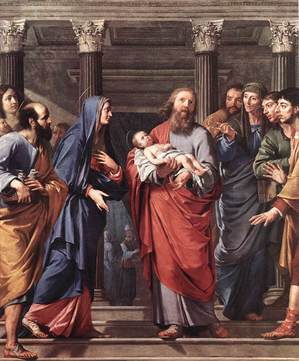 In the Latin Church there are several forms of celebrating the Sacrament of Baptism. Most Catholics today are familiar with the Rite of Baptism done according to the reforms of Pope Paul VI. Other Catholics follow the Traditional form according to the Rituale Romanum. This booklet follows this older form of the ritual.
In the Latin Church there are several forms of celebrating the Sacrament of Baptism. Most Catholics today are familiar with the Rite of Baptism done according to the reforms of Pope Paul VI. Other Catholics follow the Traditional form according to the Rituale Romanum. This booklet follows this older form of the ritual.Sacred Liturgy & Sacraments: February 2011 Archives
 In the Latin Church there are several forms of celebrating the Sacrament of Baptism. Most Catholics today are familiar with the Rite of Baptism done according to the reforms of Pope Paul VI. Other Catholics follow the Traditional form according to the Rituale Romanum. This booklet follows this older form of the ritual.
In the Latin Church there are several forms of celebrating the Sacrament of Baptism. Most Catholics today are familiar with the Rite of Baptism done according to the reforms of Pope Paul VI. Other Catholics follow the Traditional form according to the Rituale Romanum. This booklet follows this older form of the ritual.
We will be gathering to pray the Holy Mass for those living with breast cancer in honor of Saint Agatha, the patron saint of those living with breast cancer.
Saint Agatha's feast day is February 5 but for pastoral reasons, the liturgical observance will be held on the day before and the after the feast.
No one is without a family member or a friend who has breast cancer. This is an opportunity to join together in prayer and friendship with those living with ongoing trial --you could say cross-- of breast cancer.
- On Friday, February 4, at the 5:30 pm Mass at Our Lady of Pompeii Church (355 Foxon Road, Route 80, East Haven, CT), Father John Lavorgna will administer the Sacrament of the Anointing of the Sick invoking the intercession of Saint Agatha.
Let your friends know of this special Mass and anointing service. All are invited and most welcome.


Lord, hear the prayers of Your martyr Blase. Give us the joy of Your peace in this life and help us to gain the happiness that will never end.
The Church has few exact details of the life of Saint Blase (also Blaise, Biago, Sveti Vlaho) but we have the experience of his popularity through the centuries in the churches of the East and West. What we know is that Blase was a physician, the Bishop of Sebaste, Armenia and martyr. The Roman Martyrology tells us that he was beheaded in 316.
More info on Saint Blase is found here and here.
The Blessing of Candles on the feast of St Blase can be found here.
The Blessing of Bread, Wine, Water and Fruit for the feast.

From the Golden Legend again:
And when this good widow, which by S. Blase had recovered her swine, heard thereof, she slew it, and the head and the feet with a little bread and a candle, she brought to S. Blase, and he thanked God and ate thereof, and he said to her that every year she should offer in his church a candle, and know thou that to thee and to all them that so shall do shall well happen to them, and so she did all her life, and she had much great prosperity.
Even after imprisonment, he refused to worship the prince's gods, and for punishment his flesh torn by wool combs. He was finally beheaded, martyred along with seven women and two children.
Today, due to the cure of the boy's throat when the boy was choking, Saint Blase is patron against diseases or any other trouble of the throat.
The priest will bless two candles in honor of Saint Blase.
 How does one form a deacon, priest and bishop to celebrate the ars celebrandi of the sacred Liturgy? Being side-by-side these sacred ministers I am often scandalized by the lack of composure and gravitas in the praying of the Mass and other liturgical rites. Several priests and bishops I know are such poor celebrants of the Mass that I would argue that Mass celebrated so poorly does in fact lead others away from the Church's worship. And let's not even speak of the many deacons who have no clue and poor presence in the sanctuary! Two cardinals I've seen celebrate the Mass in their cathedrals have the habit of running down the isle and up the stairs into the sanctuary with evident exterior indication of what is about to happen. Another needs a seat belt in the cathedra. Is it too much to ask for beautiful gesture, beautiful music, beautiful words, beautiful art and architecture in the sacred Liturgy? Beauty and prayer also warms interpersonal relations!
How does one form a deacon, priest and bishop to celebrate the ars celebrandi of the sacred Liturgy? Being side-by-side these sacred ministers I am often scandalized by the lack of composure and gravitas in the praying of the Mass and other liturgical rites. Several priests and bishops I know are such poor celebrants of the Mass that I would argue that Mass celebrated so poorly does in fact lead others away from the Church's worship. And let's not even speak of the many deacons who have no clue and poor presence in the sanctuary! Two cardinals I've seen celebrate the Mass in their cathedrals have the habit of running down the isle and up the stairs into the sanctuary with evident exterior indication of what is about to happen. Another needs a seat belt in the cathedra. Is it too much to ask for beautiful gesture, beautiful music, beautiful words, beautiful art and architecture in the sacred Liturgy? Beauty and prayer also warms interpersonal relations! In honor of the divine mystery that we celebrate
today, let us all hasten to meet Christ. Everyone should be eager to join the procession
and to carry a light. Our lighted candle are a sign of the divine splendor of
the One who comes to expel the dark shadows of evil and to make the whole
universe radiant with the brilliance of His eternal light. Our candles show us
how bright our souls should be when we go to meet Christ.
In honor of the divine mystery that we celebrate
today, let us all hasten to meet Christ. Everyone should be eager to join the procession
and to carry a light. Our lighted candle are a sign of the divine splendor of
the One who comes to expel the dark shadows of evil and to make the whole
universe radiant with the brilliance of His eternal light. Our candles show us
how bright our souls should be when we go to meet Christ.

